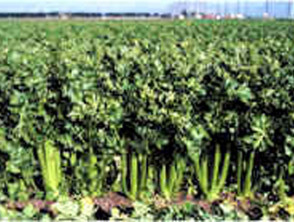| Common name: | Celery |
| Botanical name: | Apium graveolans |
| Family: | Belongs to the Umbelliferae (Apiaceae) family which includes angelica, carrot, coriander, dill, fennel, parsnip and parsley, amongst many others. |
| Origin: | Originally from the Mediterranean but is now grown commercially over the whole world. |
| Description: | A biennial plant with crisp succulant stalks, preferring to grow in a cool climate. Sewn from seed. |
| Uses: | The leaves and stalks are used in salads, as a vegetable and made into soup. Celery is thought to have some anti-inflammatory activity and some varieties appear to have beneficial effects on schistosomiasis, a tropical parasitic infestation with a blood fluke. One nutritional survey found a lower risk of stomach cancer in people who ate raw vegetables including celery. |
| Allergens: | Celery contains furanocoumarins, including xanthotoxin, bergapten and 5-methoxypsoralen, which are chemicals that react to sunlight. |
| Allergy: | Unfortunately celery can cause a number of skin reactions. If celery comes into contact with the skin, it can make the skin very sensitive to sunlight (photosensitivity); even a small amount of subsequent sun exposure can cause blistering. It seems to particularly affect pickers, canners and food store workers. Celery is prone to infection with Sclerotinia sclerotiorum (pink rot) which significantly increases the available amount of photo-sensitising chemicals. Occasionally, ingestion of these chemicals in celery soup can cause generalised sun sensitivity; several people have developed severe sunburn after eating celery soup and then going out in the sun or to a tanning salon. Celery can also cause rashes unrelated to sun exposure. There have been reports of allergic contact dermatitis (eczema), acute urticaria (hives), angio-edema (skin swelling) and anaphylaxis (severe allergy resulting in collapse) due to celery, both from direct contact with the skin and after ingestion. Fortunately these are rare. Celery oil and celery root are also known causes of acute food-induced anaphylaxis. |
| Cross reactions: | |
| Other information: | |
| Patch test: |
